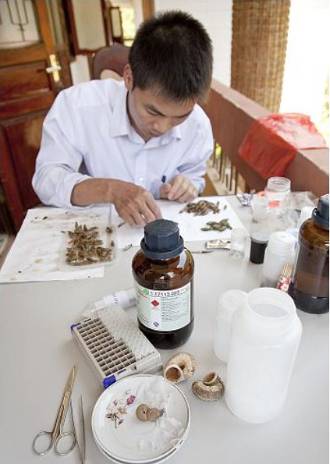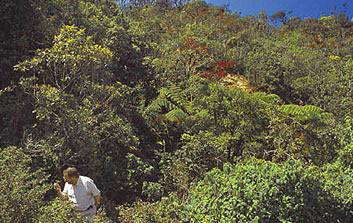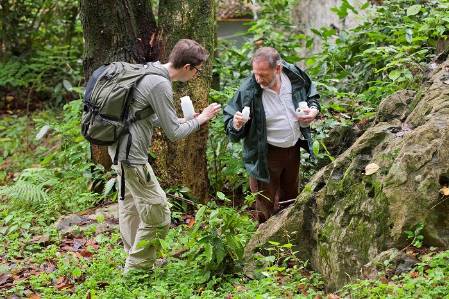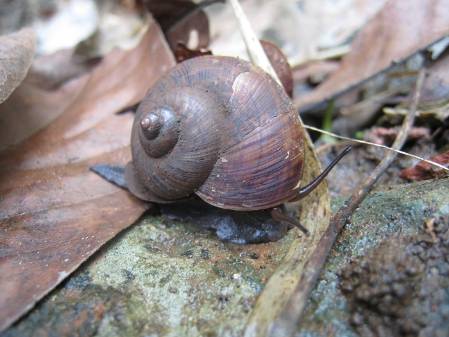Hello again - I'm sure you'll be glad to hear that we have all arrived safely in Hanoi. It's a hot and humid 25 degrees here but there has been constant heavy rain since we arrived and it looks set to continue for the next week or so. Whilst this may not sound ideal it is great weather for collecting slugs and snails as the wet weather tends to bring them out of their hiding places in the soil and the leaf litter, making them far less difficult to find and collect.
Jackie and Jonathan walk back in the rain .. how Hanoi-ing (sorry I love a bad pun).
Our first visit of today was to the Vietnam National Museum of Nature where we met the new director, Profesor Nguyen Dinh Cong and other senior staff members, and were given a tour of the new and soon to be opened exhibition spaces.
The museum opened in 2004, and houses over 40,000 animal, plant, fossil and geologicical specimens. The staff are heavily involved in studying the biodivertsity of Vietnam and promoting its importance for science and conservation, as well as in educating the local community about the natural history of Vietnam, the research and the collections that it houses.
We spent the afternoon sorting out all our collecting equipment that we need when working in the field. It's a bit like moving house packing boxes, and labeling them so that we can find everything easily when we arrive. It's good to find that everything we needed has arrived safely but I'm a bit worried about how we are going to fit it all in to our van.
Expert collectors
This seems as good place as ever to introduce you to one of the members of our team, Sang van Pham, who has previously joined us on our collecting trips in 2011 and 2012. Sang works in the Vietnam National Museum of Nature, primarily on the preservation and preparation of specimens for the collections and exhibitions, but on our trips he has become an expert in finding the smaller species that are often missed by the untrained eye.
During previous visits we have been helping to train Sang in the collection, identification and preservation of land snails, and Sang's knowledge of the biodiversity and ecology of Vietnam has been a great help in helping us to plan where we should sample on our various trips in Vietnam.
Sang van Pham sorting and preserving specimen in Vietnam in 2011.
The second member of our team I would like to introduce is Fred Naggs. Fred is the leader of the expedition and Biodiversity Officer at the Natural History Museum. His main area of interest is the diversity of terrestrial land snails in south-east Asia and India, and finding out how these species have spread over time and the factors which ave influenced their distribution.
Fred has a lot of experience in identifying and collecting snails in the tropics and always seems to know the best places to search. Although it seems to me that if this 'best place' is in an area that is hard to reach or excessively muddy it is me who is sent off to do the collecting whilst Fred stands in the dry shouting "left a bit" ... "no not that one" ... "just a bit higher" and other useful phrases.
Fred Naggs collecting snails in Sri Lanka.
Tomorrow we have an early start as we are traveling to Cuc Phuong National Park, 100 miles south-west of Hanoi, where we can start our fieldwork proper. I'm a little hesitant as the constant rain means the likelihood of being intimately attached (literally) to the local leech population is a likely occurrence.
Food update
On a side note, as someone who is mildly obssessed with food, good things I have eaten in the last 24 hours include:
- Bun-Cha: A Hanoian delicacy of grilled pork and noodles flavoured with mint, basil and a sweet sticky sauce.
- Bánh xèo: A Vietnamese pancake of pork, prawns, bean sprouts and rice batter wrapped up in a lettuce leaf - messy but delicious.
- Pho: Traditional beef noodle soup for breakfast, one of the (non-science) things I was most looking forward to on this trip (much tastier than cereal!).
Anyway, internet-availability depending, I hope to report back soon on our first day in the national park and let you know how our initial collecting went.






